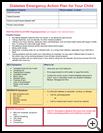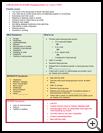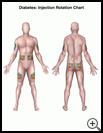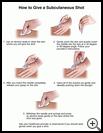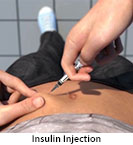
Diabetes: Giving Insulin Shots
________________________________________________________________________
KEY POINTS
- Insulin is injected into the fat layer beneath the skin. The best places to give insulin are the belly, upper arms, thighs, and buttocks. You should change where you give your child the shots each time.
- It is important to learn the right way to give an insulin shot. Your healthcare provider or diabetes educator will show you the correct way to inject insulin.
________________________________________________________________________
To give your child insulin shots you will need to learn:
- What kind or kinds of insulin you will be using
- What dosage of insulin your child needs
- When you should give insulin shots
- Where and how to inject the insulin
- How to store the insulin
If you use a prefilled pen, the insulin is not drawn from one container into another. The pen has a little plunger inside. When you set the dose on your pen, you are setting how far forward this plunger will move. This sets the amount of insulin that you get with each dose.
If you use a syringe, you also need to learn:
- What kind of syringe to use
- How to use the syringe
- What to do with used needles and syringes
Syringes come in different needle widths and lengths. Insulin syringes have thin, short needles that are easy to insert.
The amount of insulin a syringe can hold varies. Insulin is measured in units. Syringes have markings on the side that measure the units. Ask your pharmacist or healthcare provider if you have questions about needles, syringes, insulin, or dosage.
Your healthcare provider will tell you what kind of insulin to use, the dosage, and how often you should give your child a shot. Make sure your child carries a written list of the type and dose of insulin he or she uses.
Where should I inject the insulin?
Insulin is injected into the fat layer beneath the skin. The best places to give insulin are the belly, upper arms, thighs, and buttocks. There are different spots in each area where you can give the shot. You should change where you give the shots each time. For example, there might be 6 different places on the thigh that you can use. This way your child can have a shot in over 50 different spots before having to use the same place again. This is called rotating the shots. Rotating injection sites helps prevent irritation swelling.
- Do not give a shot into an area that is swollen or where there is a rash or sore.
- Do not give a shot just before a bath, shower, or hot tub. The warm water will draw more blood to the skin, causing the insulin to be absorbed more quickly. This can cause a serious low blood sugar reaction.
- Insulin is absorbed more quickly from the belly than from the arm and more quickly from the arm than from the thigh or buttock. This usually does not cause problems. If you have low blood sugar when you use some sites, you may want to use the belly or arm in the morning, and the thigh or buttock in the evening.
- If insulin is injected into an arm or leg that your child will be using a lot during exercise, your child’s body may absorb the insulin too fast. For example, if your child is going to run, don't inject insulin into the leg. If your child is going to play tennis, avoid injecting into the tennis arm.
How do I inject the insulin?
It is important to learn the right way to give an insulin shot. Your healthcare provider or diabetes educator will show you the correct way to inject insulin.
- Always wash your hands with soap and water before you give an insulin shot.
- Keep the insulin shots 1 inch away from a scar or the belly button. Do not give an insulin shot into a spot that is bruised, swollen, or tender.
- If you don’t give the shot deeply enough, it can cause a lump, pain, or red spot.
- If you give the shot too deep into the muscle it may be more painful and cause the insulin to be absorbed too quickly.
- You need to avoid injecting insulin into a large vein or artery. This is very unlikely if you are giving shots in the recommended sites. If you do inject insulin into a large vein or artery, the effect of the insulin will last just minutes instead of hours.
- Don’t worry about accidentally injecting a small bubble of air. It is not harmful.
How do I store the insulin?
It is best to store insulin in the refrigerator and warm it to room temperature before you use it. You can warm it up by holding a filled syringe between your hands for a minute or two. If you warm the insulin to room temperature, it’s less likely to sting or cause red spots on the skin.
If insulin is stored at room temperature for more than 28 days, it may not be good. Insulin will spoil if it gets above 85°F (29°C) or if it freezes. Insulin bottles and pens should not be left in a car in the summer or winter. Ask your pharmacist how your insulin should be stored.
Watch your child's blood sugar levels carefully when the insulin bottle is almost empty. If the blood sugar starts to be unusually high or low, the last bit of insulin should be thrown out. Also throw insulin away if:
- Clumps of intermediate-acting insulin are sticking to the side of the bottle.
- Clear, rapid-acting insulin looks cloudy.
- The insulin is past the expiration date.
- An open bottle has been stored at room temperature for over 28 days.
- An open bottle has been stored in the refrigerator for 3 or more months.
Can I reuse syringes?
Plastic syringes are recommended for one-time use only. If for some reason you need to reuse a syringe, after giving a shot, push the plunger up and down to get rid of any insulin left in the needle. Wipe the needle off with an alcohol swab. Put the cap over the needle and store the syringe and needle in the refrigerator until the next time you need to use it.
Needles of syringes that are reused several times may get dull from going through the rubber stopper on the insulin bottle over and over. A dull needle may cause more damage to your child's skin and tissues. There is also a risk of infection if you reuse syringes.
Last modified: 2017-11-02
Last reviewed: 2017-01-27

